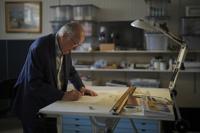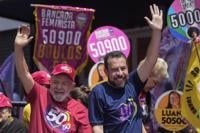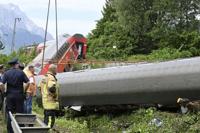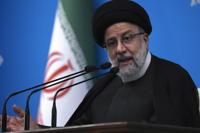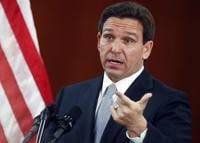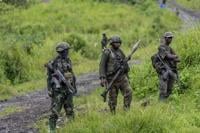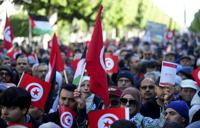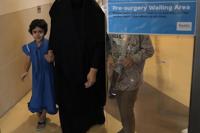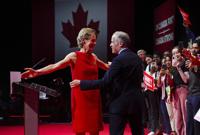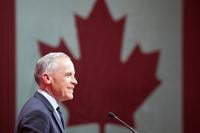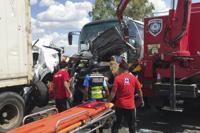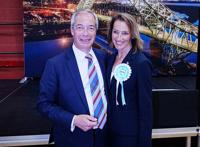LONDON (AP) — John Goldsmith was too young to fight in World War II, but he remembers the rationing, the blackouts and the bombs that devastated his neighborhood in east London. And he remembers the party when peace returned to Europe.
Church bells rang across the city, bonfires were lit and conga lines snaked through Piccadilly Circus as people filled the streets to celebrate the For a 14-year-old boy, May 8, 1945, also brought something else: an end to the tedium of wartime rules and restrictions.
“Well, it was such a contrast. Suddenly, freedom! Mucking about. Doing all sorts of things that were frowned upon as not being the right thing to do,” Goldsmith, now 94, said.
“But now, for instance, all these wonderful pictures of Piccadilly and places like that. Buses covered with people standing on the roof just going barmy — not necessarily due to drink or anything of that nature. But definitely, they were letting their hair down,’’ he added with a giggle.
Victory in Europe Day was a moment of relief for a city scarred by bombing raids and rocket attacks that killed an estimated 30,000 civilians throughout the war and didn’t end until just a few weeks earlier. But it was also a time to look forward to the safe return of husbands, sons, brothers — and sisters — who were serving abroad, and to hope that lives put on hold in 1939 might soon return to normal.
While D-Day was all about the troops who landed on the beaches of northern France to begin the liberation of Europe, V-E Day was a moment for the public, for everyone who sacrificed for the common good.
who had inspired Britain during its darkest days, caught the mood of the nation when he announced the victory at 3 p.m. on May 8.
“My dear friends, this is your hour,” he said. “This is not victory of a party or of any class. It’s a victory of the great British nation as a whole.”
That’s a message Goldsmith wants people to remember before the World War II generation fades from the scene. A retired architect and amateur artist, he has long regaled his family with stories of his boyhood in the Bow neighborhood of east London. After a bit of prodding from his wife, Margaret, he recently began sketching the scenes so others could see what he lived through.
“The soldiers, the airmen, the sailors can’t operate without the people supporting them and backing them,’’ Goldsmith said. “So if we the people don’t contribute, the armored elements will collapse. So it’s so important that V-E Day should be … the people’s day.’’
While Londoners had been anticipating the end of the fighting in Europe for weeks, the announcement was like the cork popping out of a giant bottle of champagne in a city that had lived in the shadow of war for six years.
The East Enders paid a heavy price
Nowhere was the relief felt more deeply than in the East End, where thousands of homes, schools and businesses were reduced to rubble as Nazi bombers pounded docks and warehouses along the River Thames during the onslaught that became known as The Blitz. When Buckingham Palace was bombed on Sept. 13, 1940, Queen Elizabeth reportedly told a policeman she was glad, because “it makes me feel I can look the East End in the face.”
Goldsmith's drawings capture the day The Blitz began, with Nazi bombers filling the air and fires turning the night sky a molten volcanic red behind the docks. There's also the time a cricket match was suspended as one of the flying bombs known as “doodlebugs” soared overhead, and the ghostly image of a rent collector emerging from a cloud of dust after a V-2 rocket, a type of long-range ballistic missile, obliterated a block of houses.
The last V-2 to hit London destroyed an apartment building less than two miles from his home on March 27, 1945.
Eighty years later, Goldsmith holds back tears when he remembers the moment he heard that the Nazis had surrendered.
He and his friends were playing street soccer using a tennis ball — soccer balls being scarce after six years of war — when a young boy ran out of the nearby dairy and shouted simply, “It’s over!”
“I have to be very careful now, because I could break up,’’ Goldsmith said, pausing to collect himself. “But that was the point when you realized: ‘I didn’t have to worry anymore.’”
People had seen the end coming, but didn’t dare to believe it could be true.
A wave of joy
In an era before television, Londoners flocked to the cinema to watch the weekly newsreels that charted the Allied advance toward Berlin. Goldsmith, who was just 8 when the war broke out, tracked the progress of the troops through the newspaper, carefully clipping the headlines and maps. By early 1945, he realized the surrender of the Third Reich was near.
When the news finally came, it unleashed a wave of joy that lasted for days.
Goldsmith remembers climbing the steps of St. John’s Church in Bethnal Green to see over the crowds that lined the streets as King George VI and Queen Elizabeth drove through East London to celebrate with the locals.
There were street parties and bonfires. Everyone contributed what they could with food still in short supply.
“The favorite table from the lounge was brought out in the center of the street and linked with all the other personal possessions covered up with cloth and that sort of thing,” Goldsmith remembered. “Food was magicked from somewhere, and kids gorged themselves on all sorts of cakes.”
But the celebrations were bittersweet, tempered by the knowledge that V-E Day wasn't the end of the war.
“There was a sudden realization. There was still the Japanese situation in the Far East," Goldsmith said. "And people then buckled down.’’


